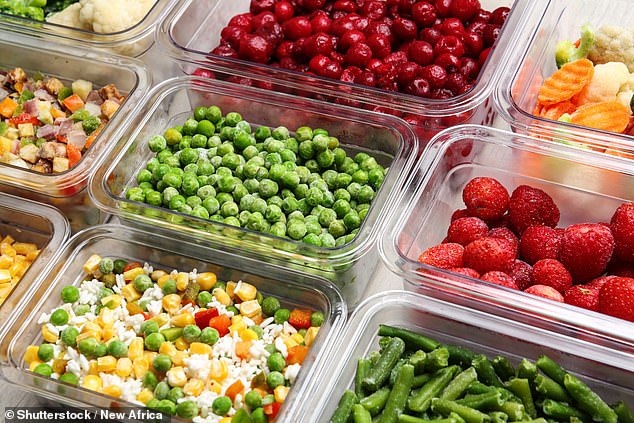Exposure to chemicals in plastic food containers, toiletries and children’s toys may lead to hundreds of thousands of deaths every year, a new study suggests.
Researchers believe phthalates could contribute to up to 107,000 premature deaths among 55- to 65-year-olds in the US per year.
The findings fuel mounting safety concerns about the harmful effect of the gender-bending chemicals, which are added to products to make them more flexible or last longer.
Over the past decade, phthalates have been linked to infertility, obesity and impaired development. Their use is limited in some countries.
Lead author Dr Leonardo Trasande, from NYU Langone Health in New York City, said the study ‘bolsters public health and business cases for reducing or eliminating the use of plastics’.
He admitted more research would be needed to provide conclusive proof that the chemicals cause early death, as well as the mechanism for how this happens.
But Trasande warned studies of that kind will never happen because they cannot ‘ethically randomise people to be exposed to potentially toxic chemicals’.

Exposure to chemicals found in plastic food containers, toiletries and children’s toys could contribute to hundreds of thousands of fatalities every year, researchers at NYU Langone Health say
Phthalates are used to make plastics more durable and are found in hundreds of products, such as flooring, plastic packaging and garden equipment.
People consume them by eating and drinking food that have been in contact with phthalate particles, or through inhaling them.
Young children may also ingest them by crawling and touching lots of things and then putting their hands in their mouth.
Once the chemicals are consumed, they breakdown and leave the body through urine – which is how they can be detected.
Levels are higher among women, which experts believe is due to use of cosmetic products.
WHAT ARE PHTHALATES? AND WHAT EVERYDAY ITEMS ARE THEY FOUND IN?
What are phthalates?
Phthalates are a group of chemicals used to soften plastic to make it more flexible.
Some of the most common phthalates are dibutyl phthalate (DBP), benzyl butyl phthalate (BBP) and disodecyl phthalate (DIDP).
Over the past decade, phthalates have been linked to infertility, obesity and impaired development. Their use is limited in some countries.
People consume them by eating and drinking food that have been in contact with phthalate particles, or through inhaling them.
Young children may also ingest them by crawling and touching lots of things and then putting their hands in their mouth.
What products are they in?
The chemicals are used in numerous everyday products.
Household products such as food packaging, cleaning products, toys, vinyl flooring and wall coverings may contain the chemicals.
They are also used in medical products, such as blood bags and tubing.
Toiletries including nail polish, hair spray, aftershave, soap, shampoo and perfume also use the chemicals.
Advertisement
For the study, researchers examined 5,303 adults aged 55 to 64 who participated in a US health survey, which occurred between 2001 and 2010.
Volunteers were asked to provide urine samples so their phthalate levels could be measured.
Their information was then linked with mortality rates among the group up to 2015.
Those with higher levels of the chemical in their body were more likely to die early from any cause, particularly cardiovascular problems, according to their study, which was published in the journal Environmental Pollution.
When extrapolating the findings to the population of Americans aged 55 to 64, 90,761 to 107,283 deaths could be attributed to the chemicals.
This equates to $39.9-$47.1billion (£29.3-£34.5billion) in lost economic productivity, researchers said.
Trasande, a professor of pediatrics, environmental medicine and population health, told CNN the chemicals ‘have a rap sheet’ and all the studies on them ‘provides a haunting pattern of concern’.
He said: ‘We already know phthalates mess with the male sex hormone, testosterone, which is a predictor of adult cardiovascular disease.
‘And we already know that these exposures can contribute to multiple conditions associated with mortality, such as obesity and diabetes.’
Phthalates were coined ‘gender-bender’ chemicals by the EU more than a decade ago after studies found they could harm children’s hormone levels, particularly in boys by causing lower testosterone levels, reduced sperm count and a higher risk of testicular cancer.
The US, EU, Canada, Israel, Brazil, Hong Kong, Australia and China have restricted or banned use of the chemicals in toys.
But the researchers have called for further action to limit food from coming into contact with phthalates.
However, Dr Trasande noted the findings only show a link between the chemicals and higher risk of death and is not definitive.
‘It is a snapshot in time and can only show an association,’ he added.
People can reduce their exposure to phthalates and other problem chemicals – such as BPA, which is found in plastic food containers and drink bottles – by avoiding plastics, the experts said.
Heating up plastic – such as by putting them in the microwave or dishwasher – should also be avoided, they said, because this encourages harmful chemicals to breakdown and be more easily consumed.
Exposure can also be reduced by using unscented toiletries and cleaning supplies, using non-plastic containers to store food and regular hand washing to remove chemicals.
The American Chemistry Council, the trade association for chemical companies, told CNN that much of the findings are ‘demonstrably inaccurate’.
The research groups all phthalates together ‘and failed to mention that the industry says high-molecular-weight phthalates like DINP and DIDP have lower toxicity than other phthalates’, it said.
Source link : https://www.dailymail.co.uk/health/article-10083457/Chemicals-popular-consumer-products-contribute-100-000-early-deaths-year-US.html











